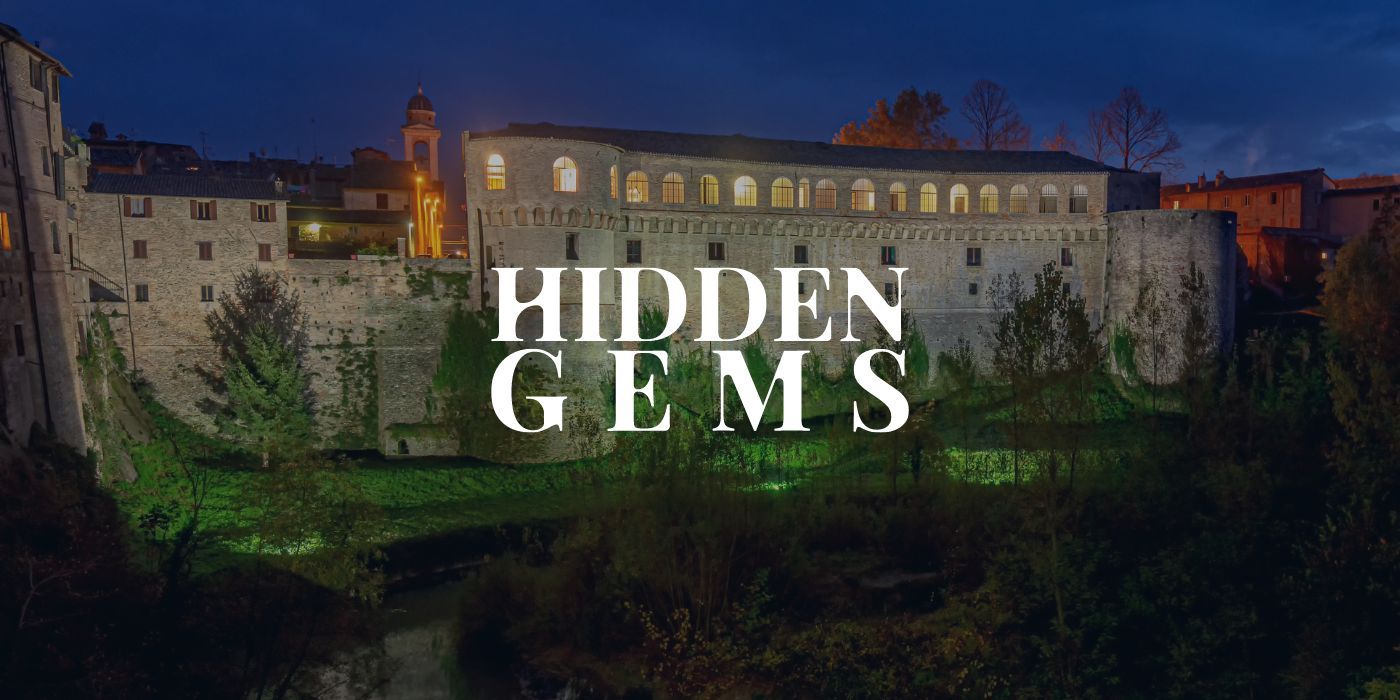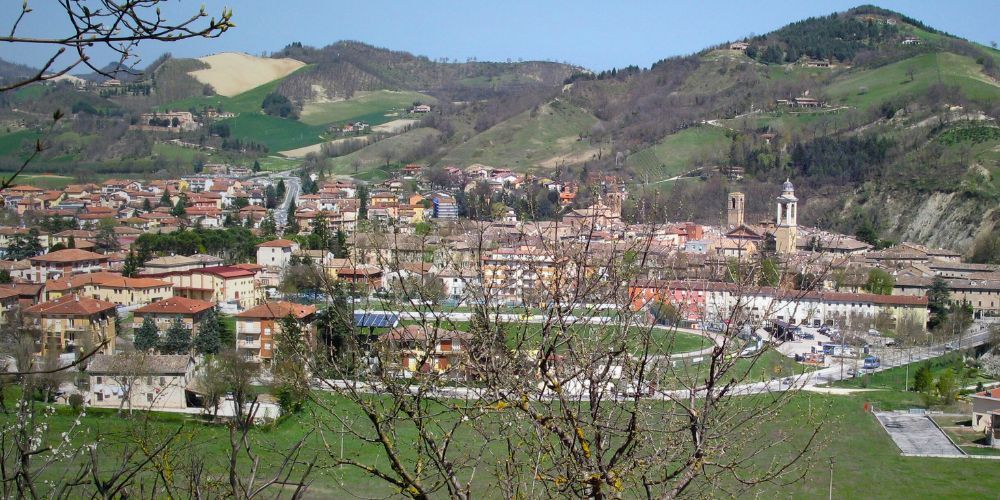On the edge of the ancient Montefeltro region, more precisely in the north of Le Marche a few kilometers away from Urbino, there is a small medieval village rich in history, culture and beauty that awaits you on your next trip to central Italy: today we’re in Urbania, formerly known as Casteldurante, considered the 'city of Befana' as well as one of the Italian capitals of the production of colorful ceramics and majolica.
However, despite its small size, the village really has a lot to offer for the most curious travelers. So, get ready, and let's set out right away to discover what to see in Urbania, a hidden gem not to be missed when traveling across Le Marche!
(Original cover picture from Wikimedia Commons; Author: Perpaulo40)

Where is Urbania and how to get there
As mentioned earlier, Urbania is a small village in the province of Pesaro-Urbino in the north of the Marche, a border territory that embraces within a few kilometers the territories of Umbria, Tuscany, Romagna too, and nearby San Marino as well. How to get to Urbania? Let's see together the best itineraries considering different starting points and means of transport.
Starting from nearby Urbino, you can easily get around by car along the SS73bis road or even by bus. For sporty visitors, it is also possible to travel by bike, with a ride of just over an hour along the internal provincial road along the banks of the Metauro river.
Starting from Pesaro instead, the route by car involves traveling along Via delle Regioni/Via Monteabbatese (SS746), subsequently taking the SP423 to Urbino and the SS73bis up to your destination; daily buses are also available for the same route.
Starting from Ancona, moving by car you need to reach Fano driving on the SS16, near Pesaro, then continuing on the SS73bis up to your destination. With public transport, however, you can reach Pesaro by train and continue by bus to Urbania.
By the way, just south of Ancona there is the splendid town of Recanati, homeland of Giacomo Leopardi: find out how to best visit it with us!
Find out the best attractions of RecanatiTo reach Urbania starting from Tuscany, the main city to consider is Arezzo, the most important crossroads on the border with the other regions of central Italy. And if you feel like stopping in the city for a while, we suggest you visit its wonderful cathedral: take a look at the button below!
But let's get back to us. In particular, starting from Arezzo, the best means of transport to reach Urbania is certainly the car, along state and local roads itineraries (SS73, SP/SS221, SR/SP257, SP21; or, alternatively, the SS73 and SS73bis) which will take you to your destination among truly evocative and authentic landscapes of central Italy, crossing the borders of nearby Umbria before getting to Urbania, in Le Marche.
Visit the Cathedral of ArezzoTo reach Urbania starting from Umbria we consider Perugia as a point of reference, the capital of the region, geographically positioned in the middle of the territory. In particular, traveling by car, the most intuitive route involves driving on the SS3bis up to Città di Castello, then continuing on the SR/SP257 roads and finally on the SP21 up to your destination.
If Umbria is one of the stages on your journey to discover the beauty and authenticity of central Italy, then you absolutely cannot miss a guided tour of one of the wineries in Montefalco, a charming village south-east of Perugia.
Visit the wineries in MontefalcoLast but not least, the route to reach Urbania starting from Romagna, in particular obviously starting from Rimini: we suggest you drive on the SS16 and enjoy the landscape of the Riviera, also passing by the beautiful town of Gradara with its magical castle, and once in Pesaro follow the road signs for the SP423 which leads to Urbino; from there, continue on the SS73bis up to Urbania. And if you're willing to stay in Rimini for a while, we have something for you right below here!
Visit the Fellini Museum in RiminiWhat to see in Urbania: the best attractions in town
Well, now that we have come in this splendid village in Le Marche we can begin our tour to discover what to see in Urbania, in particular by exploring its suggestive historic centre. Crossed by the waters of the Metauro and enclosed in a bight embraced by the river, the historic center of Urbania is in fact a place full of charm and attractions to discover.
The most representative symbol of the city is certainly Palazzo Ducale, a true masterpiece of Renaissance construction (dated back to 1470) built entirely in cotto tile which, despite the typical aesthetic appearance similar to a fortress where its two cylindrical towers stand out, it catches the attention for its elegant and refined artistic style. It is a testimony to the power and influence of the lordship of Urbino on the territory of Urbania.
Inside, between the internal rooms and the characteristic courtyards, Palazzo Ducale houses a library, an art gallery and a museum. Among the most valuable pieces in the Urbania collection there are: Dante's Divine Comedy published in 1491, two Mercatore globes dating back to 1500s, ancient ceramics handcrafted by the village's masters and interesting works of sacred art such as Mary of the Clouds by Barocci.
The internal courtyards of Palazzo Ducale are characterized above all by the porticoes that outline all their perimeters. This peculiarity is also clearly visible throughout the city; walking through the alleys of the historic center of Urbania, in fact, you couldn’t miss to notice the presence of the porticoes on both sides of the streets!
And speaking of strolling around Urbania... another place to visit is certainly Piazza San Cristoforo, the access point to the historic center from inside the village. Here you can admire the column of San Cristoforo, a monument dedicated to the Saint, and in particular Teatro Bramante, a 1800s building in Neoclassical style which stands out from the city landscape due to the color of its external facade, kind of reddish. One of the most beautiful details of the square, however, are the ceramics: in fact, here these works of art are often displayed as tourist attractions, on the occasion of particular events or, more simply, to embellish the scenography of this splendid town - a perfect glimpse for a beautiful postcard from Urbania!
Walking on discovering what to see in Urbania, let yourself be guided by the beauty of the alleys of this village and take a look around with a careful eye in search of splendid moments to photograph.
From Piazza San Cristoforo we continue along Corso Vittorio Emanuele II, towards the next stop: the Urbania Cathedral dedicated to San Cristoforo, the main church of the city dating back to the 1700s. Despite the very sober external aesthetic appearance, characterized by a reddish facade like the town’s theater and the presence of two small statues, the interior of the building instead gives much more emphasis to the baroque style both in art and architecture: a place which in its simple elegance transmits a strong sense of connection with the divine, even more so when face to face with the beauty of its wonderful wooden crucifix dating back to the first half of the 1300s, handcrafted by Pietro da Rimini.
Having visited the sober city cathedral, it is time to continue towards the Town Hall of Urbania: it is a building of 1500s origin, also very modest from a decorative point of view, home to the municipal offices as well as an icon of the historic center with its civic tower standing out over the roofs of Urbania with its approximately 30 meters height.
Let’s keep exploring the historic center of Urbania, continuing from the Town Hall along Via Ugolini, in a way the most 'mystical' alley of the city. In fact, crossing this road with its evocative atmosphere that takes you back to old ages from the past, you will be able to visit three other important churches in Urbania.
The first is the Church of Santa Caterina, formerly the seat of the so-called artists brotherhood, a small building renovated during the 1500s on the basis of the previous medieval foundation, apparently anonymous from the outside but which inside, magically, reveals a truly notable artistic treasure where especially the walls and ceiling decorated with high quality stuccos stand out. Further ahead is the Church of San Francesco, of medieval origin (1284), founded by the first community of Franciscan monks settled in the territory of Urbania.
But there is still the third church to discover, a decidedly particular place that cannot be seen everywhere... let's discover it together, come with us.
And here we are, a few meters further on, reaching the Cola Chapel, a building dating back to 1380 which is now famous throughout the world with the disturbing nickname of Church of the Dead. Yes, because in the internal crypt of this chapel there is something that is rarely found elsewhere: a room containing 18 perfectly preserved mummies arranged in a semicircle inside special protective glass cases, in a whole scenario with a Gothic taste that combines horror and fear with charm and mystery.
The Church of the Dead of Urbania, today one of the most famous and important attractions of the village, was also the subject of a National Geographic special show, creating a documentary on the history of this particular place by putting together the life and death of the 18 mummies.
Scared, huh? Well, quite understandable, but the hidden charm of Italy is also made up of these places out of the ordinary and the common idea of 'tourist attraction'. And speaking of attractions, the walk through Urbania is not over yet.
Going forward, in fact, by turning right it is possible to venture into the narrow alley of the city walls, while on the left you get to the iconic Ponte del Riscatto over Metauro - a small bridge named so in honor of the Madonna del Riscatto - from which you can stop for a while and enjoy a splendid view of the external facade of Palazzo Ducale over the waters of the river.
To conclude our visit to this corner of Le Marche to discover what to see in Urbania, we now leave the town center behind us, moving a little further north of the city: our last stop is the Barco Ducale, or Villa del Parco Ducale of Urbania.
This wonderful rural residence, with the annexed convent in honor of San Giovanni Battista, is one of the most beautiful places to visit in Urbania and its surroundings with an extraordinary landscape of the beauty of nature and the countryside of North Le Marche. A fantastic place for taking walks and taking wonderful photos to create iconic postcards from Urbania, where in every season it is possible to admire the wonders of nature among spectacular sunsets, flowering meadows and above all fields full of sunflowers.
What to see in Urbania: the Befana festival

Well, here we are at the end of this fascinating journey through the beauties of ancient Casteldurante, among ceramics, porticoes, esoteric places and majestic palaces. Now you will be able to travel discovering the north of Le Marche with clear ideas about what to see in Urbania... yes, that's fine, but when is the best time to visit it? Well, certainly in the first days of the year on the occasion of the Epiphany, or popularly known as Befana!
Here in Urbania, in fact, there is a very strong cultural bond with the lively old lady who, on the night between 5 and 6 January, flies from house to house on her magic broom to give sweets and toys to children who have behaved well - otherwise, lots and lots of coal! The village is in fact recognized as the authentic 'city of Befana', an acknowledgment that has been earned over time in particular thanks to the annual celebration that fills all its alleys with colors, joy and cheerfulness, especially to the delight of children.
The Befana Festival of Urbania is a fantastic event, among the most renowned of its kind in Italy, with thousands of tourists who every year decide to visit the best witch in the world within the evocative setting of the village of Urbania. This is an important occasion that proudly highlights the Italian folklore linked to this character, much loved by adults and children, and the beauty of this territory which has fully embraced his cultural imprint.
The celebrations of Urbania are always full of fun, imagination and many delicacies, with the involvement of artistic and theatrical associations and themed events to enliven the days of celebration and the setting up of stands to host the Befana workshops, including the traditional socks, lots of sweets and candies. There are so many attractions not to be missed at the Epiphany Festival in Urbania! But you know, Befana takes all the holidays away...stay up to date with the sprightly old lady's agenda by taking a look at the official program and seize the opportunity to visit this splendid village in Le Marche!
About the author
Written on 05/01/2024





Massimiliano Antonio Primi
Traveling across Le Marche? Let’s find out what to see in Urbania, formerly Casteldurante famous for its ceramics and for being the ‘city of Befana’.